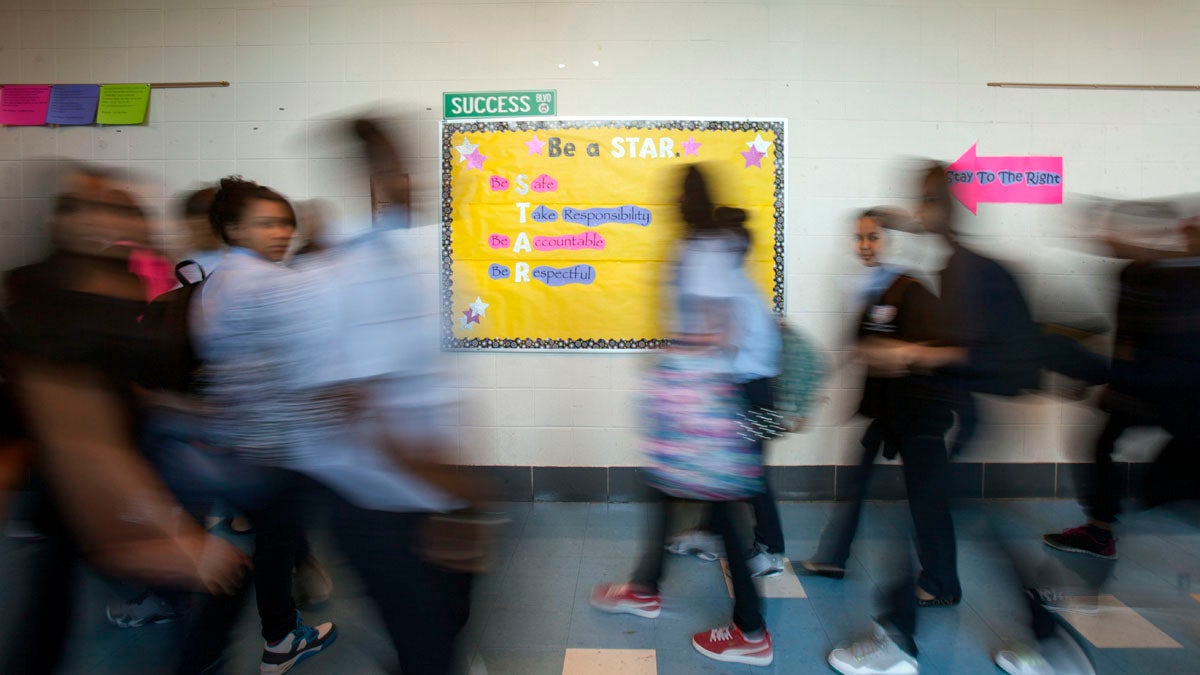Philly school-quality scores show modest growth
The district's SPR metric is designed to help measure school quality. The numbers suggest Philly schools have improved slightly over three years.

Middle school students change classes (Jessica Kourkounis for WHYY, file)
Philadelphia public schools made modest progress last year, according to the district’s internal school-quality metric, with “turnaround” schools posting some of the biggest gains.
The district released its latest batch of School Progress Reports Monday. Each traditional public and charter school received an SPR score between 0 and 100 for the 2016-17 school year.
(To find your school’s results click here.)
Key takeaways
- The citywide average SPR score went from 35 percent to 37 percent. In the prior school year (2014-15), the citywide average was 33 percent — so this is the second consecutive year of positive growth.
- Out of 319 district and charter schools, 164 schools increased in overall SPR score. That’s just slightly more than half (51.4 percent).
- Some of the biggest year-to-year growth occurred in the district’s “Turnaround Network,” a special cohort of struggling schools where the district mandates major shake-ups. Of these 16 schools, 13 improved on the SPR scale. On average, turnaround schools improved 8 percentage points, the largest jump among any of the district’s networks (most of which are based on geography).
- The district also named the best schools in each grade band as determined by SPR. They are Anne Frank (elementary), Penn Alexander, Masterman (middle school), and Central (high school).
The district designed SPR as a catchall quality metric, although past reporting has called into question its usefulness as a year-to-year measure of improvement. SPR has four components: achievement (as measured by test scores); progress (as measured by test scores compared to previous years); climate; and career and college readiness.
A school’s overall SPR is a composite of these four groupings, and schools are slotted into one of four categories based on their score: intervene (0-24), watch (25-49), reinforce (50-74), or model (75-100).
High scorers earn plaudits from district officials and positive attention from parents. Habitually low-scoring schools can be entered into the district’s Turnaround Network, and slated for major interventions.
Evaluating new approach
The Turnaround Network is the latest in the district’s long line of rehabilitation strategies for struggling schools. Like its predecessors, the Turnaround Network stokes controversy. Some schools receive new leadership and new staff. Others get new academic approaches. Sometimes, community resistance accompanies a school’s entry into the network.
But district officials say these new SPR results suggest the approach is working.
Take Potter-Thomas School in North Philadelphia, for instance. The school has been subject to multiple turnaround efforts in the past decade, but in 2016-17 jumped a remarkable 32 points in SPR, from 9 to 41.
“I was amazed,” said longtime principal Dywonne Davis-Harris with a laugh. “I had to look at it twice to say, is this right?”
Davis-Harris attributes the growth to a new academic strategy that emphasized personalized instruction in small groups.
The 2016-17 school year was the first time the district grouped these intervention schools into the Turnaround Network, according to Eric Becoats, the network’s assistant superintendent.
Some of the schools that made big strides underwent major staff turnover. Others had teacher continuity. The common factor across schools that did best, Becoats said, was their buy-in.
“I think the staff has to want to be a part of the model,” he said.
Other schools singled out for shaky performance in the past experienced big SPR gains in 2016-17.
The district is currently trying to determine whether the Feltonville School of Arts and Sciences should become a turnaround school. Meanwhile, Feltonville jumped from 13 to 46 in SPR.
A school run by the Universal charter network, once scheduled for closure, also showed big gains. Universal Bluford went from 44 to 71. Two other Universal schools (Alcorn and Creighton) were honored as “peer leaders” in the K-8 grade band.
Standouts
These schools were honored as among the best at their respective grade levels.
Elementary: Feltonville Intermediate School, Universal Bluford, Holme Elementary.
K-8: Pan American, Universal Alcorn, Universal Creighton, Antonia Pantoja, Discovery Charter, Philadelphia Academy, Kirkbride, and Keystone Academy.
Middle school: Esperanza Academy and Young Scholars.
High school: Mastery Pickett, Mariana Bracetti, Multicultural Academy Charter School, Academy at Palumbo, and Carver.
The most improved district schools in each grade band were:
J.B. Kelly (elementary), E.M. Stanton (K-8), Feltonville Arts and Sciences (middle), and Constitution (high school).
Several of the schools that made big gains still have relatively low overall test scores, with less than 20 percent of students scoring at the levels of proficient or advanced on state assessments.
For many, the jump in SPR reflected big gains in the “progress” category, which accounts for year-to-year school improvement.
WHYY is your source for fact-based, in-depth journalism and information. As a nonprofit organization, we rely on financial support from readers like you. Please give today.





